Master of Business Administration Project: Digi Telecommunication Plan
VerifiedAdded on 2022/08/26
|43
|16801
|17
Project
AI Summary
This Master of Business Administration project presents a comprehensive business development plan for Digi Telecommunication in Malaysia. The project begins with an executive summary outlining the plan's objectives and action items, followed by an introduction providing background information on Digi and the Malaysian telecommunications industry. It includes PESTLE and SWOT analyses of both the company and the industry, along with a review of Digi's business operations, marketing, human capital, technology, and operational aspects of competitors. The research design and data collection methods are detailed, and the project identifies critical success and risk factors. The plan aims to enhance Digi's business performance through strategic recommendations based on thorough analysis.
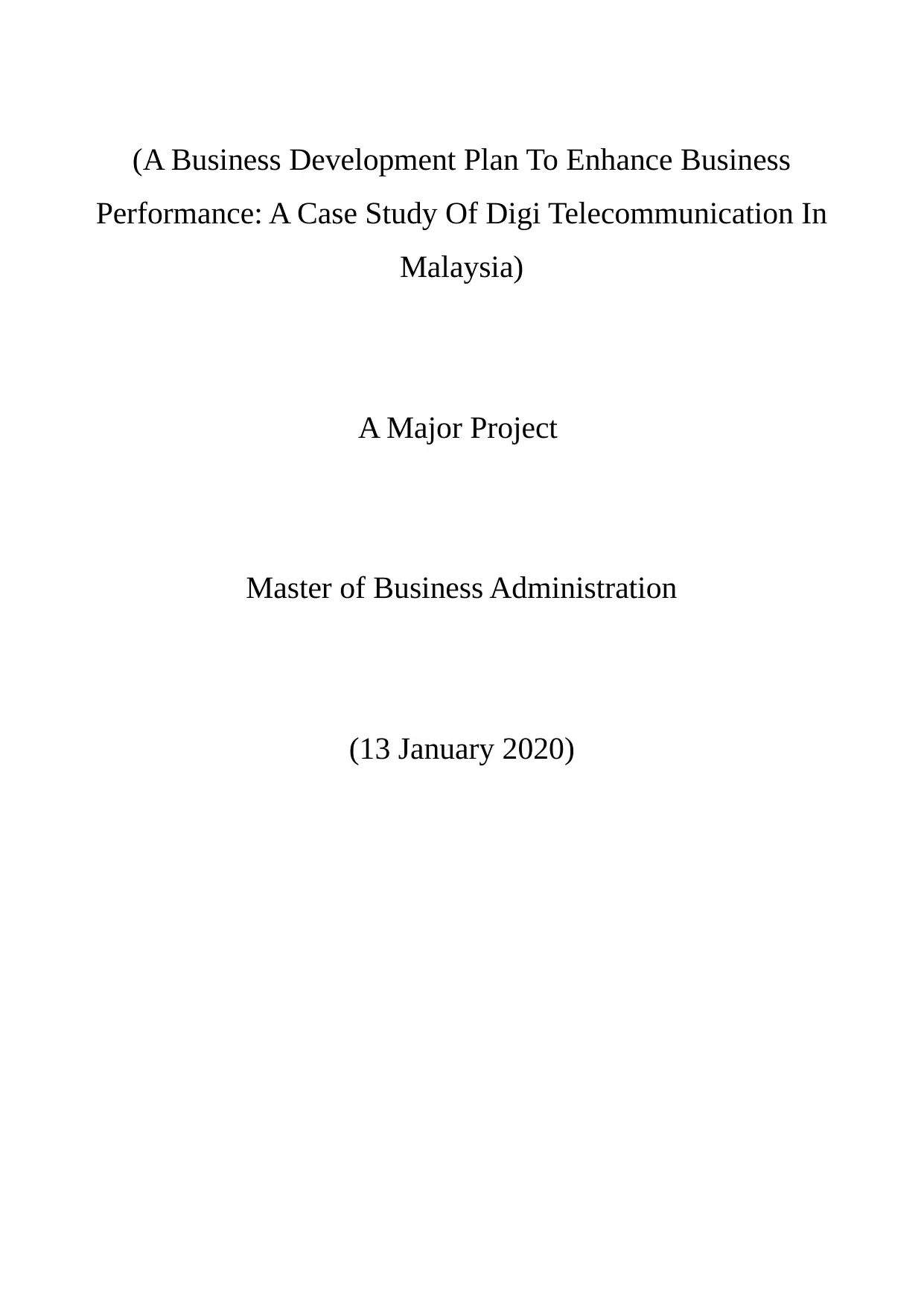
(A Business Development Plan To Enhance Business
Performance: A Case Study Of Digi Telecommunication In
Malaysia)
A Major Project
Master of Business Administration
(13 January 2020)
Performance: A Case Study Of Digi Telecommunication In
Malaysia)
A Major Project
Master of Business Administration
(13 January 2020)
Paraphrase This Document
Need a fresh take? Get an instant paraphrase of this document with our AI Paraphraser

Executive Summary
The concept behind a business development plan is to develop the necessary documents to for
implementing a business strategy for the development of the business plan. It is necessary that for this
particular purpose, the business that is about to have a development plan has a necessary analysis done
about the ongoing business procedures. The entire analysis before the development plan includes the
ongoing processes, the transactional data and the business perspectives to be analyzed as well. This is
why, the organization of Digi Telecommunications, situated in Malaysia would find out several
information about the company for its business development plan based on the findings through the
analysis. The analysis would include the background information about the organization, the background
information about the industry that the organization belongs followed by the PESTLE analysis of both the
organization and the industry. Furthermore, there would be the representation of the SWOT analysis of
both the industry and the organization for having an overall understanding of the analysis done for the
featured ongoing business and industry processes. This would be followed by the purpose and the
rationale of the research and analyses with the developed research questions, aims and objectives in
support of the research. The research framework, the business review, the analysis of the review of Digi
Telecommunications would follow next. Furthermore, the marketing aspects, the human capital aspects,
the technology and innovation aspects and the operational aspects of the competitors would also be
analyzed. The research procedure and design will be described in details to focus on the data collection
methods and the analysis of the collected data. The critical success factors and the risk factors would also
be researched about so that before the final developmental plan is set up, the business could ensure having
the overall information required about the company to have a feasible plan.
The concept behind a business development plan is to develop the necessary documents to for
implementing a business strategy for the development of the business plan. It is necessary that for this
particular purpose, the business that is about to have a development plan has a necessary analysis done
about the ongoing business procedures. The entire analysis before the development plan includes the
ongoing processes, the transactional data and the business perspectives to be analyzed as well. This is
why, the organization of Digi Telecommunications, situated in Malaysia would find out several
information about the company for its business development plan based on the findings through the
analysis. The analysis would include the background information about the organization, the background
information about the industry that the organization belongs followed by the PESTLE analysis of both the
organization and the industry. Furthermore, there would be the representation of the SWOT analysis of
both the industry and the organization for having an overall understanding of the analysis done for the
featured ongoing business and industry processes. This would be followed by the purpose and the
rationale of the research and analyses with the developed research questions, aims and objectives in
support of the research. The research framework, the business review, the analysis of the review of Digi
Telecommunications would follow next. Furthermore, the marketing aspects, the human capital aspects,
the technology and innovation aspects and the operational aspects of the competitors would also be
analyzed. The research procedure and design will be described in details to focus on the data collection
methods and the analysis of the collected data. The critical success factors and the risk factors would also
be researched about so that before the final developmental plan is set up, the business could ensure having
the overall information required about the company to have a feasible plan.
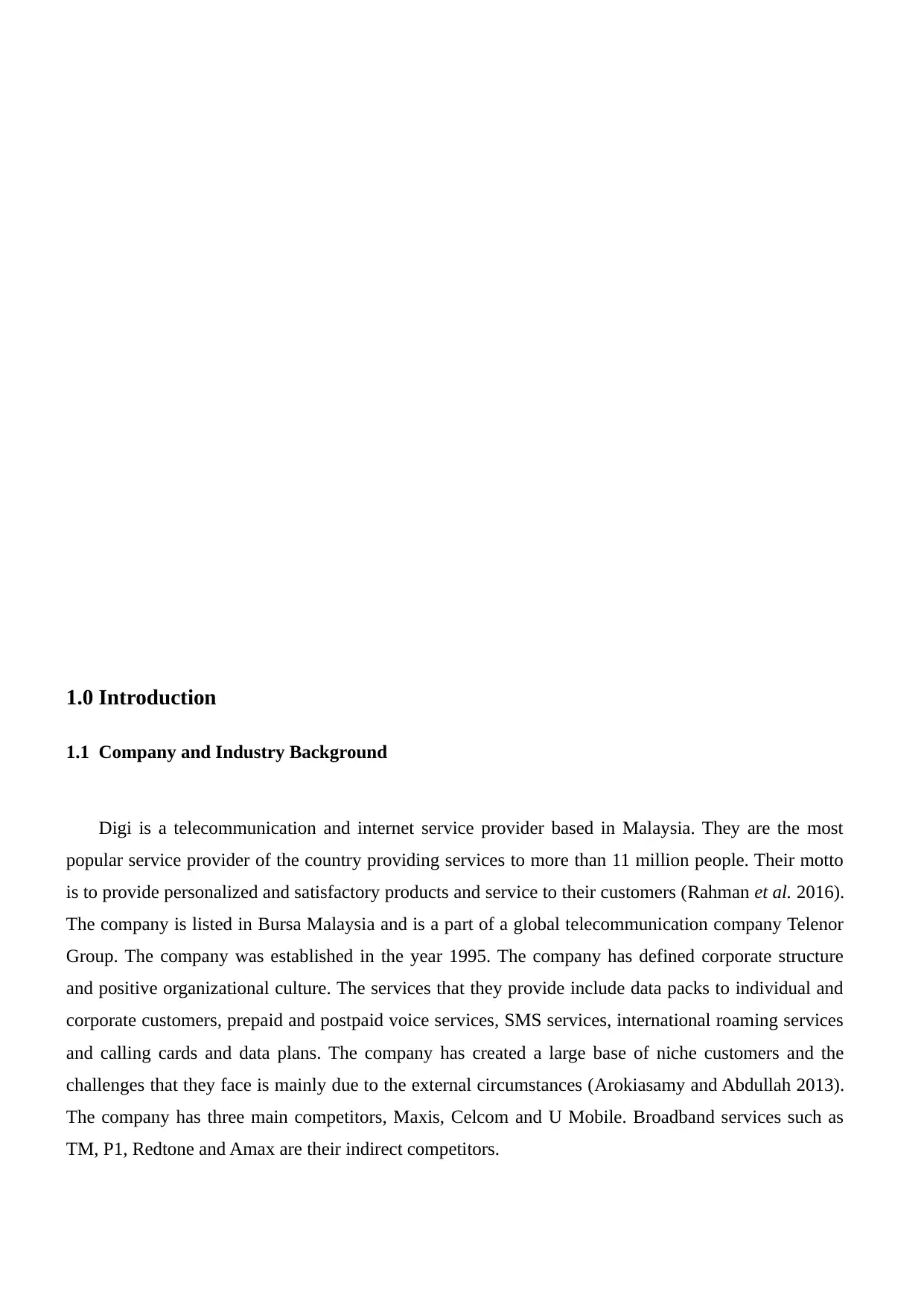
1.0 Introduction
1.1 Company and Industry Background
Digi is a telecommunication and internet service provider based in Malaysia. They are the most
popular service provider of the country providing services to more than 11 million people. Their motto
is to provide personalized and satisfactory products and service to their customers (Rahman et al. 2016).
The company is listed in Bursa Malaysia and is a part of a global telecommunication company Telenor
Group. The company was established in the year 1995. The company has defined corporate structure
and positive organizational culture. The services that they provide include data packs to individual and
corporate customers, prepaid and postpaid voice services, SMS services, international roaming services
and calling cards and data plans. The company has created a large base of niche customers and the
challenges that they face is mainly due to the external circumstances (Arokiasamy and Abdullah 2013).
The company has three main competitors, Maxis, Celcom and U Mobile. Broadband services such as
TM, P1, Redtone and Amax are their indirect competitors.
1.1 Company and Industry Background
Digi is a telecommunication and internet service provider based in Malaysia. They are the most
popular service provider of the country providing services to more than 11 million people. Their motto
is to provide personalized and satisfactory products and service to their customers (Rahman et al. 2016).
The company is listed in Bursa Malaysia and is a part of a global telecommunication company Telenor
Group. The company was established in the year 1995. The company has defined corporate structure
and positive organizational culture. The services that they provide include data packs to individual and
corporate customers, prepaid and postpaid voice services, SMS services, international roaming services
and calling cards and data plans. The company has created a large base of niche customers and the
challenges that they face is mainly due to the external circumstances (Arokiasamy and Abdullah 2013).
The company has three main competitors, Maxis, Celcom and U Mobile. Broadband services such as
TM, P1, Redtone and Amax are their indirect competitors.
⊘ This is a preview!⊘
Do you want full access?
Subscribe today to unlock all pages.

Trusted by 1+ million students worldwide
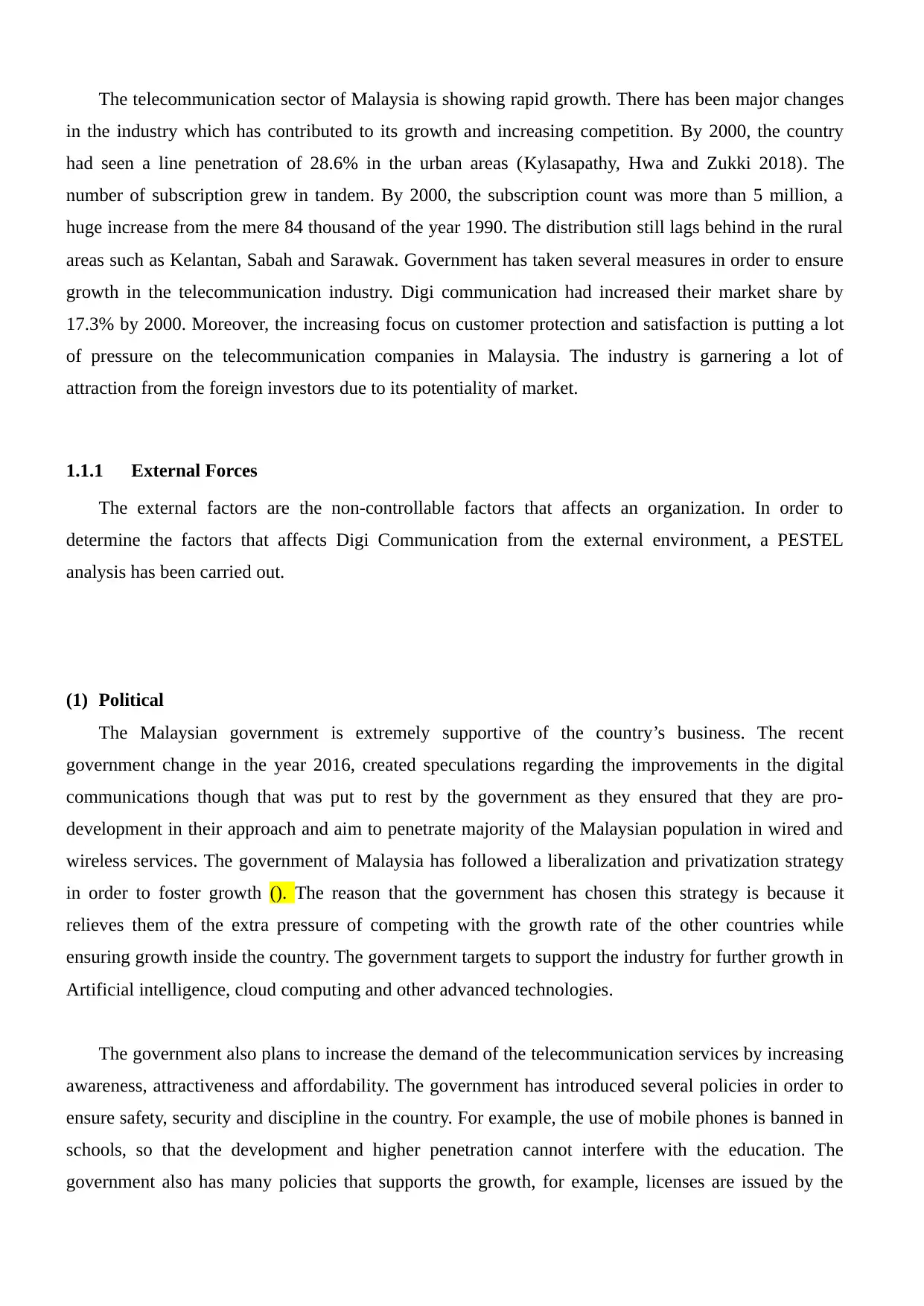
The telecommunication sector of Malaysia is showing rapid growth. There has been major changes
in the industry which has contributed to its growth and increasing competition. By 2000, the country
had seen a line penetration of 28.6% in the urban areas (Kylasapathy, Hwa and Zukki 2018). The
number of subscription grew in tandem. By 2000, the subscription count was more than 5 million, a
huge increase from the mere 84 thousand of the year 1990. The distribution still lags behind in the rural
areas such as Kelantan, Sabah and Sarawak. Government has taken several measures in order to ensure
growth in the telecommunication industry. Digi communication had increased their market share by
17.3% by 2000. Moreover, the increasing focus on customer protection and satisfaction is putting a lot
of pressure on the telecommunication companies in Malaysia. The industry is garnering a lot of
attraction from the foreign investors due to its potentiality of market.
1.1.1 External Forces
The external factors are the non-controllable factors that affects an organization. In order to
determine the factors that affects Digi Communication from the external environment, a PESTEL
analysis has been carried out.
(1) Political
The Malaysian government is extremely supportive of the country’s business. The recent
government change in the year 2016, created speculations regarding the improvements in the digital
communications though that was put to rest by the government as they ensured that they are pro-
development in their approach and aim to penetrate majority of the Malaysian population in wired and
wireless services. The government of Malaysia has followed a liberalization and privatization strategy
in order to foster growth (). The reason that the government has chosen this strategy is because it
relieves them of the extra pressure of competing with the growth rate of the other countries while
ensuring growth inside the country. The government targets to support the industry for further growth in
Artificial intelligence, cloud computing and other advanced technologies.
The government also plans to increase the demand of the telecommunication services by increasing
awareness, attractiveness and affordability. The government has introduced several policies in order to
ensure safety, security and discipline in the country. For example, the use of mobile phones is banned in
schools, so that the development and higher penetration cannot interfere with the education. The
government also has many policies that supports the growth, for example, licenses are issued by the
in the industry which has contributed to its growth and increasing competition. By 2000, the country
had seen a line penetration of 28.6% in the urban areas (Kylasapathy, Hwa and Zukki 2018). The
number of subscription grew in tandem. By 2000, the subscription count was more than 5 million, a
huge increase from the mere 84 thousand of the year 1990. The distribution still lags behind in the rural
areas such as Kelantan, Sabah and Sarawak. Government has taken several measures in order to ensure
growth in the telecommunication industry. Digi communication had increased their market share by
17.3% by 2000. Moreover, the increasing focus on customer protection and satisfaction is putting a lot
of pressure on the telecommunication companies in Malaysia. The industry is garnering a lot of
attraction from the foreign investors due to its potentiality of market.
1.1.1 External Forces
The external factors are the non-controllable factors that affects an organization. In order to
determine the factors that affects Digi Communication from the external environment, a PESTEL
analysis has been carried out.
(1) Political
The Malaysian government is extremely supportive of the country’s business. The recent
government change in the year 2016, created speculations regarding the improvements in the digital
communications though that was put to rest by the government as they ensured that they are pro-
development in their approach and aim to penetrate majority of the Malaysian population in wired and
wireless services. The government of Malaysia has followed a liberalization and privatization strategy
in order to foster growth (). The reason that the government has chosen this strategy is because it
relieves them of the extra pressure of competing with the growth rate of the other countries while
ensuring growth inside the country. The government targets to support the industry for further growth in
Artificial intelligence, cloud computing and other advanced technologies.
The government also plans to increase the demand of the telecommunication services by increasing
awareness, attractiveness and affordability. The government has introduced several policies in order to
ensure safety, security and discipline in the country. For example, the use of mobile phones is banned in
schools, so that the development and higher penetration cannot interfere with the education. The
government also has many policies that supports the growth, for example, licenses are issued by the
Paraphrase This Document
Need a fresh take? Get an instant paraphrase of this document with our AI Paraphraser
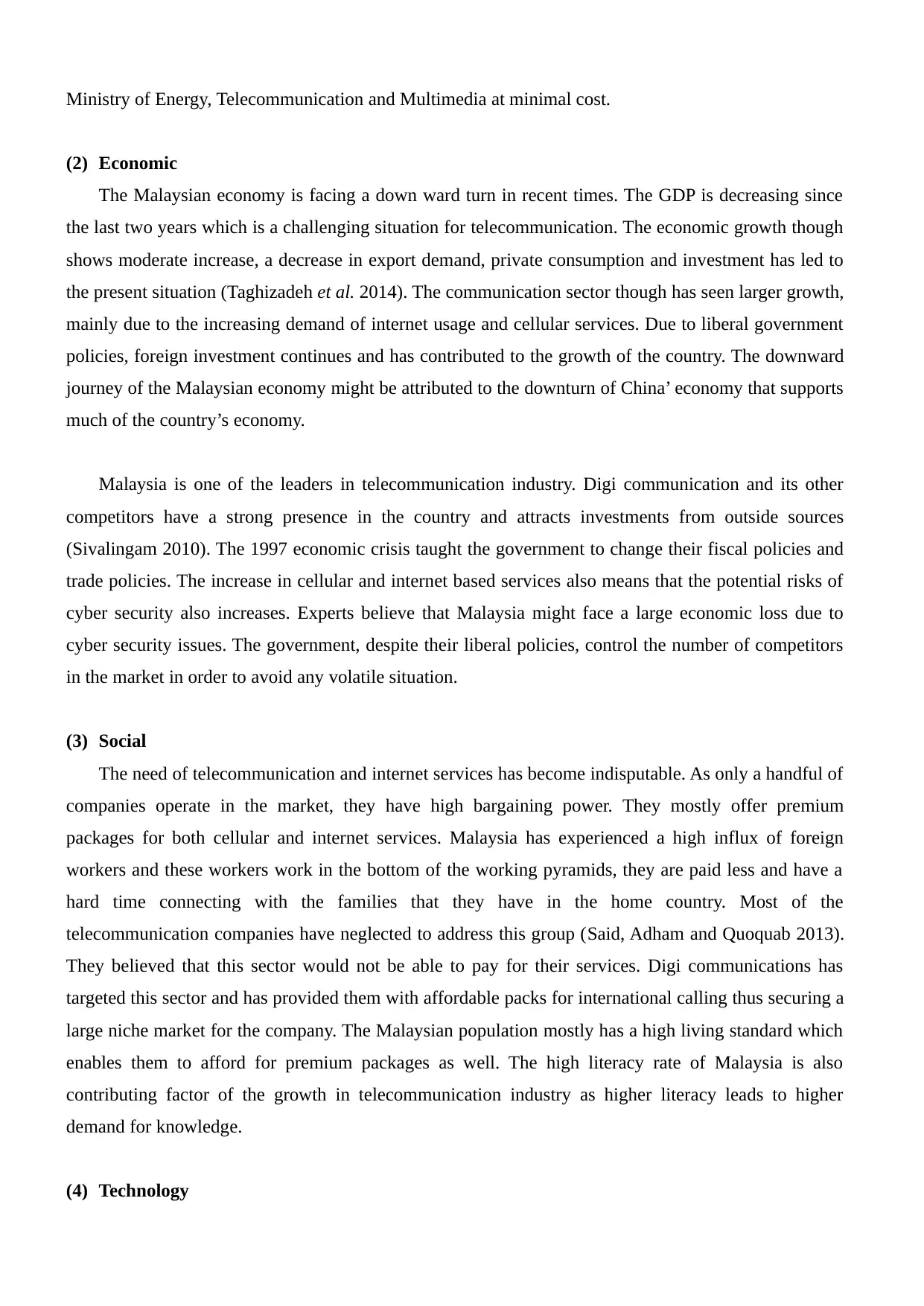
Ministry of Energy, Telecommunication and Multimedia at minimal cost.
(2) Economic
The Malaysian economy is facing a down ward turn in recent times. The GDP is decreasing since
the last two years which is a challenging situation for telecommunication. The economic growth though
shows moderate increase, a decrease in export demand, private consumption and investment has led to
the present situation (Taghizadeh et al. 2014). The communication sector though has seen larger growth,
mainly due to the increasing demand of internet usage and cellular services. Due to liberal government
policies, foreign investment continues and has contributed to the growth of the country. The downward
journey of the Malaysian economy might be attributed to the downturn of China’ economy that supports
much of the country’s economy.
Malaysia is one of the leaders in telecommunication industry. Digi communication and its other
competitors have a strong presence in the country and attracts investments from outside sources
(Sivalingam 2010). The 1997 economic crisis taught the government to change their fiscal policies and
trade policies. The increase in cellular and internet based services also means that the potential risks of
cyber security also increases. Experts believe that Malaysia might face a large economic loss due to
cyber security issues. The government, despite their liberal policies, control the number of competitors
in the market in order to avoid any volatile situation.
(3) Social
The need of telecommunication and internet services has become indisputable. As only a handful of
companies operate in the market, they have high bargaining power. They mostly offer premium
packages for both cellular and internet services. Malaysia has experienced a high influx of foreign
workers and these workers work in the bottom of the working pyramids, they are paid less and have a
hard time connecting with the families that they have in the home country. Most of the
telecommunication companies have neglected to address this group (Said, Adham and Quoquab 2013).
They believed that this sector would not be able to pay for their services. Digi communications has
targeted this sector and has provided them with affordable packs for international calling thus securing a
large niche market for the company. The Malaysian population mostly has a high living standard which
enables them to afford for premium packages as well. The high literacy rate of Malaysia is also
contributing factor of the growth in telecommunication industry as higher literacy leads to higher
demand for knowledge.
(4) Technology
(2) Economic
The Malaysian economy is facing a down ward turn in recent times. The GDP is decreasing since
the last two years which is a challenging situation for telecommunication. The economic growth though
shows moderate increase, a decrease in export demand, private consumption and investment has led to
the present situation (Taghizadeh et al. 2014). The communication sector though has seen larger growth,
mainly due to the increasing demand of internet usage and cellular services. Due to liberal government
policies, foreign investment continues and has contributed to the growth of the country. The downward
journey of the Malaysian economy might be attributed to the downturn of China’ economy that supports
much of the country’s economy.
Malaysia is one of the leaders in telecommunication industry. Digi communication and its other
competitors have a strong presence in the country and attracts investments from outside sources
(Sivalingam 2010). The 1997 economic crisis taught the government to change their fiscal policies and
trade policies. The increase in cellular and internet based services also means that the potential risks of
cyber security also increases. Experts believe that Malaysia might face a large economic loss due to
cyber security issues. The government, despite their liberal policies, control the number of competitors
in the market in order to avoid any volatile situation.
(3) Social
The need of telecommunication and internet services has become indisputable. As only a handful of
companies operate in the market, they have high bargaining power. They mostly offer premium
packages for both cellular and internet services. Malaysia has experienced a high influx of foreign
workers and these workers work in the bottom of the working pyramids, they are paid less and have a
hard time connecting with the families that they have in the home country. Most of the
telecommunication companies have neglected to address this group (Said, Adham and Quoquab 2013).
They believed that this sector would not be able to pay for their services. Digi communications has
targeted this sector and has provided them with affordable packs for international calling thus securing a
large niche market for the company. The Malaysian population mostly has a high living standard which
enables them to afford for premium packages as well. The high literacy rate of Malaysia is also
contributing factor of the growth in telecommunication industry as higher literacy leads to higher
demand for knowledge.
(4) Technology
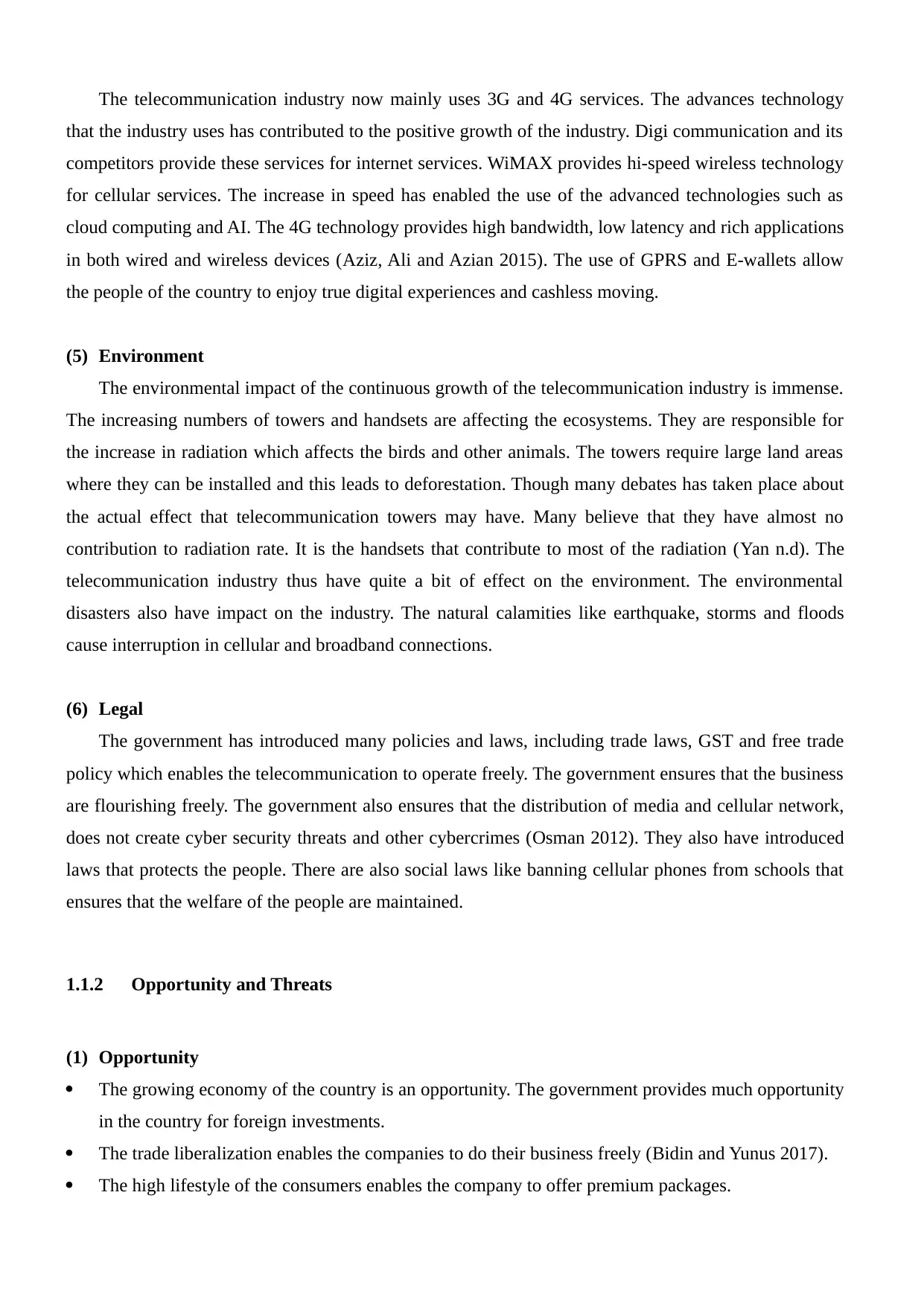
The telecommunication industry now mainly uses 3G and 4G services. The advances technology
that the industry uses has contributed to the positive growth of the industry. Digi communication and its
competitors provide these services for internet services. WiMAX provides hi-speed wireless technology
for cellular services. The increase in speed has enabled the use of the advanced technologies such as
cloud computing and AI. The 4G technology provides high bandwidth, low latency and rich applications
in both wired and wireless devices (Aziz, Ali and Azian 2015). The use of GPRS and E-wallets allow
the people of the country to enjoy true digital experiences and cashless moving.
(5) Environment
The environmental impact of the continuous growth of the telecommunication industry is immense.
The increasing numbers of towers and handsets are affecting the ecosystems. They are responsible for
the increase in radiation which affects the birds and other animals. The towers require large land areas
where they can be installed and this leads to deforestation. Though many debates has taken place about
the actual effect that telecommunication towers may have. Many believe that they have almost no
contribution to radiation rate. It is the handsets that contribute to most of the radiation (Yan n.d). The
telecommunication industry thus have quite a bit of effect on the environment. The environmental
disasters also have impact on the industry. The natural calamities like earthquake, storms and floods
cause interruption in cellular and broadband connections.
(6) Legal
The government has introduced many policies and laws, including trade laws, GST and free trade
policy which enables the telecommunication to operate freely. The government ensures that the business
are flourishing freely. The government also ensures that the distribution of media and cellular network,
does not create cyber security threats and other cybercrimes (Osman 2012). They also have introduced
laws that protects the people. There are also social laws like banning cellular phones from schools that
ensures that the welfare of the people are maintained.
1.1.2 Opportunity and Threats
(1) Opportunity
The growing economy of the country is an opportunity. The government provides much opportunity
in the country for foreign investments.
The trade liberalization enables the companies to do their business freely (Bidin and Yunus 2017).
The high lifestyle of the consumers enables the company to offer premium packages.
that the industry uses has contributed to the positive growth of the industry. Digi communication and its
competitors provide these services for internet services. WiMAX provides hi-speed wireless technology
for cellular services. The increase in speed has enabled the use of the advanced technologies such as
cloud computing and AI. The 4G technology provides high bandwidth, low latency and rich applications
in both wired and wireless devices (Aziz, Ali and Azian 2015). The use of GPRS and E-wallets allow
the people of the country to enjoy true digital experiences and cashless moving.
(5) Environment
The environmental impact of the continuous growth of the telecommunication industry is immense.
The increasing numbers of towers and handsets are affecting the ecosystems. They are responsible for
the increase in radiation which affects the birds and other animals. The towers require large land areas
where they can be installed and this leads to deforestation. Though many debates has taken place about
the actual effect that telecommunication towers may have. Many believe that they have almost no
contribution to radiation rate. It is the handsets that contribute to most of the radiation (Yan n.d). The
telecommunication industry thus have quite a bit of effect on the environment. The environmental
disasters also have impact on the industry. The natural calamities like earthquake, storms and floods
cause interruption in cellular and broadband connections.
(6) Legal
The government has introduced many policies and laws, including trade laws, GST and free trade
policy which enables the telecommunication to operate freely. The government ensures that the business
are flourishing freely. The government also ensures that the distribution of media and cellular network,
does not create cyber security threats and other cybercrimes (Osman 2012). They also have introduced
laws that protects the people. There are also social laws like banning cellular phones from schools that
ensures that the welfare of the people are maintained.
1.1.2 Opportunity and Threats
(1) Opportunity
The growing economy of the country is an opportunity. The government provides much opportunity
in the country for foreign investments.
The trade liberalization enables the companies to do their business freely (Bidin and Yunus 2017).
The high lifestyle of the consumers enables the company to offer premium packages.
⊘ This is a preview!⊘
Do you want full access?
Subscribe today to unlock all pages.

Trusted by 1+ million students worldwide
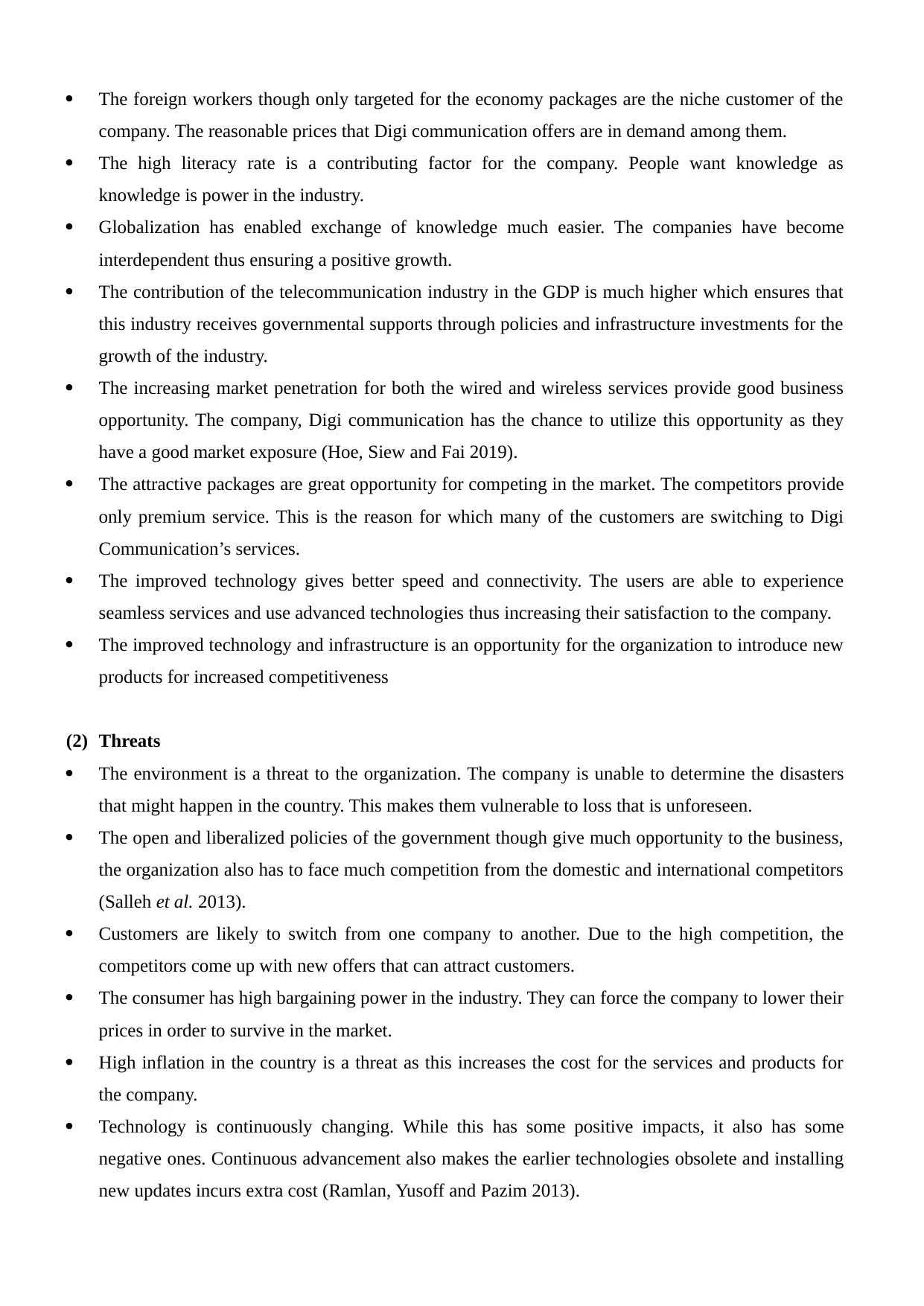
The foreign workers though only targeted for the economy packages are the niche customer of the
company. The reasonable prices that Digi communication offers are in demand among them.
The high literacy rate is a contributing factor for the company. People want knowledge as
knowledge is power in the industry.
Globalization has enabled exchange of knowledge much easier. The companies have become
interdependent thus ensuring a positive growth.
The contribution of the telecommunication industry in the GDP is much higher which ensures that
this industry receives governmental supports through policies and infrastructure investments for the
growth of the industry.
The increasing market penetration for both the wired and wireless services provide good business
opportunity. The company, Digi communication has the chance to utilize this opportunity as they
have a good market exposure (Hoe, Siew and Fai 2019).
The attractive packages are great opportunity for competing in the market. The competitors provide
only premium service. This is the reason for which many of the customers are switching to Digi
Communication’s services.
The improved technology gives better speed and connectivity. The users are able to experience
seamless services and use advanced technologies thus increasing their satisfaction to the company.
The improved technology and infrastructure is an opportunity for the organization to introduce new
products for increased competitiveness
(2) Threats
The environment is a threat to the organization. The company is unable to determine the disasters
that might happen in the country. This makes them vulnerable to loss that is unforeseen.
The open and liberalized policies of the government though give much opportunity to the business,
the organization also has to face much competition from the domestic and international competitors
(Salleh et al. 2013).
Customers are likely to switch from one company to another. Due to the high competition, the
competitors come up with new offers that can attract customers.
The consumer has high bargaining power in the industry. They can force the company to lower their
prices in order to survive in the market.
High inflation in the country is a threat as this increases the cost for the services and products for
the company.
Technology is continuously changing. While this has some positive impacts, it also has some
negative ones. Continuous advancement also makes the earlier technologies obsolete and installing
new updates incurs extra cost (Ramlan, Yusoff and Pazim 2013).
company. The reasonable prices that Digi communication offers are in demand among them.
The high literacy rate is a contributing factor for the company. People want knowledge as
knowledge is power in the industry.
Globalization has enabled exchange of knowledge much easier. The companies have become
interdependent thus ensuring a positive growth.
The contribution of the telecommunication industry in the GDP is much higher which ensures that
this industry receives governmental supports through policies and infrastructure investments for the
growth of the industry.
The increasing market penetration for both the wired and wireless services provide good business
opportunity. The company, Digi communication has the chance to utilize this opportunity as they
have a good market exposure (Hoe, Siew and Fai 2019).
The attractive packages are great opportunity for competing in the market. The competitors provide
only premium service. This is the reason for which many of the customers are switching to Digi
Communication’s services.
The improved technology gives better speed and connectivity. The users are able to experience
seamless services and use advanced technologies thus increasing their satisfaction to the company.
The improved technology and infrastructure is an opportunity for the organization to introduce new
products for increased competitiveness
(2) Threats
The environment is a threat to the organization. The company is unable to determine the disasters
that might happen in the country. This makes them vulnerable to loss that is unforeseen.
The open and liberalized policies of the government though give much opportunity to the business,
the organization also has to face much competition from the domestic and international competitors
(Salleh et al. 2013).
Customers are likely to switch from one company to another. Due to the high competition, the
competitors come up with new offers that can attract customers.
The consumer has high bargaining power in the industry. They can force the company to lower their
prices in order to survive in the market.
High inflation in the country is a threat as this increases the cost for the services and products for
the company.
Technology is continuously changing. While this has some positive impacts, it also has some
negative ones. Continuous advancement also makes the earlier technologies obsolete and installing
new updates incurs extra cost (Ramlan, Yusoff and Pazim 2013).
Paraphrase This Document
Need a fresh take? Get an instant paraphrase of this document with our AI Paraphraser

1.2 Business Issue
The business issue is to address the issues encountered that affected the business performance of Digi
Communication in Malaysia.
1.3 Purpose and Rationale
(1) Purpose
The purpose of this project is to develop a business plan to improve the business performance of Digi
Telecommunication in Malaysia.
(2) Rationale
1. The company needs to enhance their sales in the next three years.
2. The organization needs to increase their market penetration in the rural areas.
3. The company needs to secure more loyal customers in order to increase their brand image.
1.4 Terms of Reference
(1) Research Questions
The research questions related to the study are:
1. How does the marketing effectiveness affect the business performance of Digi Communication in
Malaysia?
2. What is the influence of human capital effectiveness on the business performance of Digi
Communication in Malaysia?
3. What is the impact of technology & innovation efficiency on the business performance of Digi
Communication in Malaysia?
4. How does operational efficiency lead to the business performance of Digi Communication in
Malaysia?
(2) Research Objectives
The objective of the research is to
1. To identify the marketing factors that could affect Digi Telecommunication in doing business in
Malaysia.
The business issue is to address the issues encountered that affected the business performance of Digi
Communication in Malaysia.
1.3 Purpose and Rationale
(1) Purpose
The purpose of this project is to develop a business plan to improve the business performance of Digi
Telecommunication in Malaysia.
(2) Rationale
1. The company needs to enhance their sales in the next three years.
2. The organization needs to increase their market penetration in the rural areas.
3. The company needs to secure more loyal customers in order to increase their brand image.
1.4 Terms of Reference
(1) Research Questions
The research questions related to the study are:
1. How does the marketing effectiveness affect the business performance of Digi Communication in
Malaysia?
2. What is the influence of human capital effectiveness on the business performance of Digi
Communication in Malaysia?
3. What is the impact of technology & innovation efficiency on the business performance of Digi
Communication in Malaysia?
4. How does operational efficiency lead to the business performance of Digi Communication in
Malaysia?
(2) Research Objectives
The objective of the research is to
1. To identify the marketing factors that could affect Digi Telecommunication in doing business in
Malaysia.

2. To discover the human capital factors that may contribute to the business performance of Digi
Telecommunication in Malaysia.
3. To analyze the technology & innovation factors that could impact the business performance of Digi
Telecommunication in Malaysia
4. To determine the business operation efficiency can enhance Digi Telecommunication's business
performance in Malaysia.
(3) Research Framework
Telecommunication in Malaysia.
3. To analyze the technology & innovation factors that could impact the business performance of Digi
Telecommunication in Malaysia
4. To determine the business operation efficiency can enhance Digi Telecommunication's business
performance in Malaysia.
(3) Research Framework
⊘ This is a preview!⊘
Do you want full access?
Subscribe today to unlock all pages.

Trusted by 1+ million students worldwide
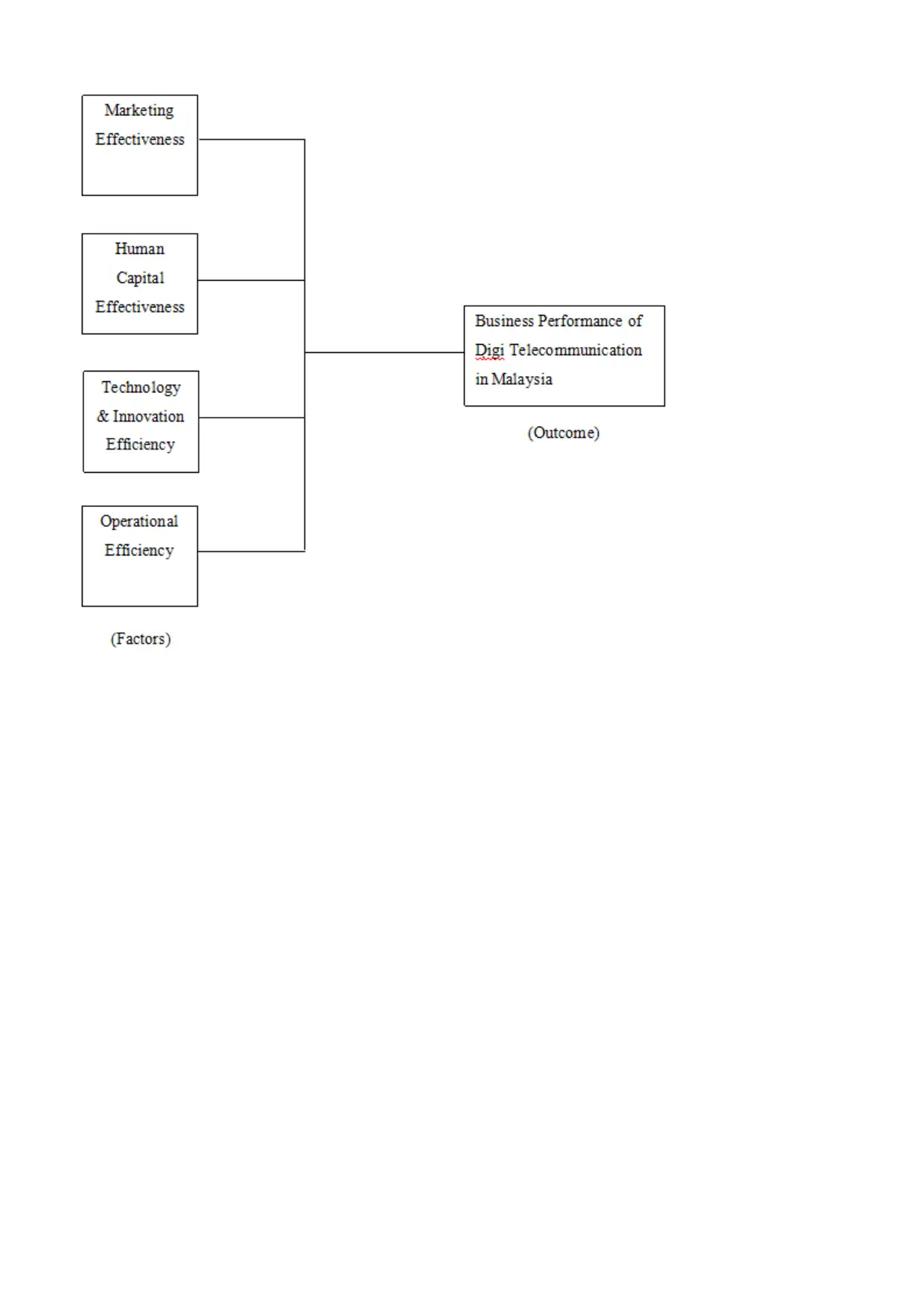
Paraphrase This Document
Need a fresh take? Get an instant paraphrase of this document with our AI Paraphraser
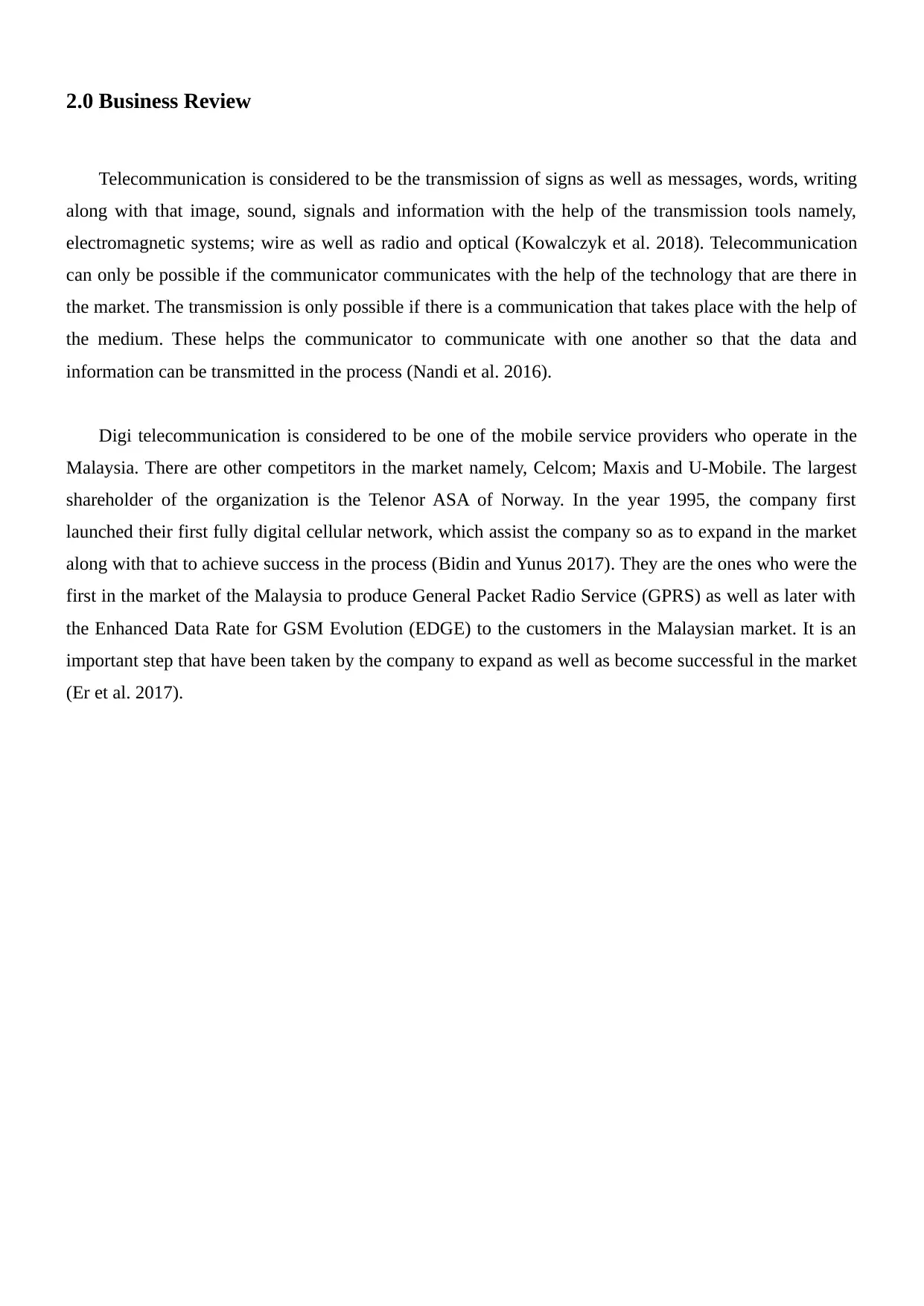
2.0 Business Review
Telecommunication is considered to be the transmission of signs as well as messages, words, writing
along with that image, sound, signals and information with the help of the transmission tools namely,
electromagnetic systems; wire as well as radio and optical (Kowalczyk et al. 2018). Telecommunication
can only be possible if the communicator communicates with the help of the technology that are there in
the market. The transmission is only possible if there is a communication that takes place with the help of
the medium. These helps the communicator to communicate with one another so that the data and
information can be transmitted in the process (Nandi et al. 2016).
Digi telecommunication is considered to be one of the mobile service providers who operate in the
Malaysia. There are other competitors in the market namely, Celcom; Maxis and U-Mobile. The largest
shareholder of the organization is the Telenor ASA of Norway. In the year 1995, the company first
launched their first fully digital cellular network, which assist the company so as to expand in the market
along with that to achieve success in the process (Bidin and Yunus 2017). They are the ones who were the
first in the market of the Malaysia to produce General Packet Radio Service (GPRS) as well as later with
the Enhanced Data Rate for GSM Evolution (EDGE) to the customers in the Malaysian market. It is an
important step that have been taken by the company to expand as well as become successful in the market
(Er et al. 2017).
Telecommunication is considered to be the transmission of signs as well as messages, words, writing
along with that image, sound, signals and information with the help of the transmission tools namely,
electromagnetic systems; wire as well as radio and optical (Kowalczyk et al. 2018). Telecommunication
can only be possible if the communicator communicates with the help of the technology that are there in
the market. The transmission is only possible if there is a communication that takes place with the help of
the medium. These helps the communicator to communicate with one another so that the data and
information can be transmitted in the process (Nandi et al. 2016).
Digi telecommunication is considered to be one of the mobile service providers who operate in the
Malaysia. There are other competitors in the market namely, Celcom; Maxis and U-Mobile. The largest
shareholder of the organization is the Telenor ASA of Norway. In the year 1995, the company first
launched their first fully digital cellular network, which assist the company so as to expand in the market
along with that to achieve success in the process (Bidin and Yunus 2017). They are the ones who were the
first in the market of the Malaysia to produce General Packet Radio Service (GPRS) as well as later with
the Enhanced Data Rate for GSM Evolution (EDGE) to the customers in the Malaysian market. It is an
important step that have been taken by the company to expand as well as become successful in the market
(Er et al. 2017).
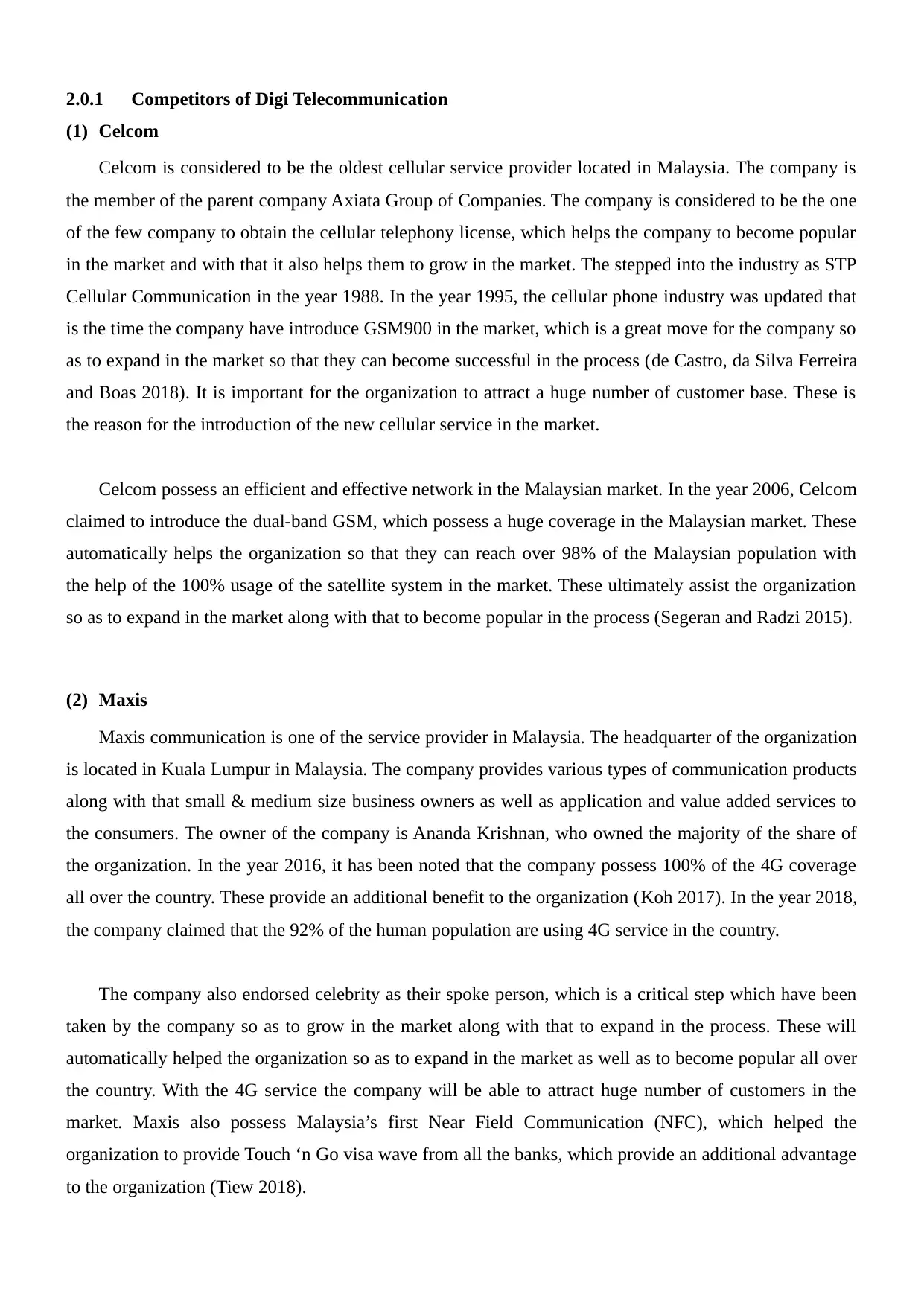
2.0.1 Competitors of Digi Telecommunication
(1) Celcom
Celcom is considered to be the oldest cellular service provider located in Malaysia. The company is
the member of the parent company Axiata Group of Companies. The company is considered to be the one
of the few company to obtain the cellular telephony license, which helps the company to become popular
in the market and with that it also helps them to grow in the market. The stepped into the industry as STP
Cellular Communication in the year 1988. In the year 1995, the cellular phone industry was updated that
is the time the company have introduce GSM900 in the market, which is a great move for the company so
as to expand in the market so that they can become successful in the process (de Castro, da Silva Ferreira
and Boas 2018). It is important for the organization to attract a huge number of customer base. These is
the reason for the introduction of the new cellular service in the market.
Celcom possess an efficient and effective network in the Malaysian market. In the year 2006, Celcom
claimed to introduce the dual-band GSM, which possess a huge coverage in the Malaysian market. These
automatically helps the organization so that they can reach over 98% of the Malaysian population with
the help of the 100% usage of the satellite system in the market. These ultimately assist the organization
so as to expand in the market along with that to become popular in the process (Segeran and Radzi 2015).
(2) Maxis
Maxis communication is one of the service provider in Malaysia. The headquarter of the organization
is located in Kuala Lumpur in Malaysia. The company provides various types of communication products
along with that small & medium size business owners as well as application and value added services to
the consumers. The owner of the company is Ananda Krishnan, who owned the majority of the share of
the organization. In the year 2016, it has been noted that the company possess 100% of the 4G coverage
all over the country. These provide an additional benefit to the organization (Koh 2017). In the year 2018,
the company claimed that the 92% of the human population are using 4G service in the country.
The company also endorsed celebrity as their spoke person, which is a critical step which have been
taken by the company so as to grow in the market along with that to expand in the process. These will
automatically helped the organization so as to expand in the market as well as to become popular all over
the country. With the 4G service the company will be able to attract huge number of customers in the
market. Maxis also possess Malaysia’s first Near Field Communication (NFC), which helped the
organization to provide Touch ‘n Go visa wave from all the banks, which provide an additional advantage
to the organization (Tiew 2018).
(1) Celcom
Celcom is considered to be the oldest cellular service provider located in Malaysia. The company is
the member of the parent company Axiata Group of Companies. The company is considered to be the one
of the few company to obtain the cellular telephony license, which helps the company to become popular
in the market and with that it also helps them to grow in the market. The stepped into the industry as STP
Cellular Communication in the year 1988. In the year 1995, the cellular phone industry was updated that
is the time the company have introduce GSM900 in the market, which is a great move for the company so
as to expand in the market so that they can become successful in the process (de Castro, da Silva Ferreira
and Boas 2018). It is important for the organization to attract a huge number of customer base. These is
the reason for the introduction of the new cellular service in the market.
Celcom possess an efficient and effective network in the Malaysian market. In the year 2006, Celcom
claimed to introduce the dual-band GSM, which possess a huge coverage in the Malaysian market. These
automatically helps the organization so that they can reach over 98% of the Malaysian population with
the help of the 100% usage of the satellite system in the market. These ultimately assist the organization
so as to expand in the market along with that to become popular in the process (Segeran and Radzi 2015).
(2) Maxis
Maxis communication is one of the service provider in Malaysia. The headquarter of the organization
is located in Kuala Lumpur in Malaysia. The company provides various types of communication products
along with that small & medium size business owners as well as application and value added services to
the consumers. The owner of the company is Ananda Krishnan, who owned the majority of the share of
the organization. In the year 2016, it has been noted that the company possess 100% of the 4G coverage
all over the country. These provide an additional benefit to the organization (Koh 2017). In the year 2018,
the company claimed that the 92% of the human population are using 4G service in the country.
The company also endorsed celebrity as their spoke person, which is a critical step which have been
taken by the company so as to grow in the market along with that to expand in the process. These will
automatically helped the organization so as to expand in the market as well as to become popular all over
the country. With the 4G service the company will be able to attract huge number of customers in the
market. Maxis also possess Malaysia’s first Near Field Communication (NFC), which helped the
organization to provide Touch ‘n Go visa wave from all the banks, which provide an additional advantage
to the organization (Tiew 2018).
⊘ This is a preview!⊘
Do you want full access?
Subscribe today to unlock all pages.

Trusted by 1+ million students worldwide
1 out of 43
Related Documents
Your All-in-One AI-Powered Toolkit for Academic Success.
+13062052269
info@desklib.com
Available 24*7 on WhatsApp / Email
![[object Object]](/_next/static/media/star-bottom.7253800d.svg)
Unlock your academic potential
Copyright © 2020–2025 A2Z Services. All Rights Reserved. Developed and managed by ZUCOL.





